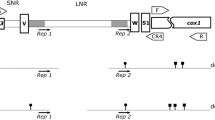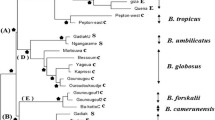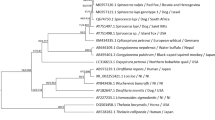Abstract
Avian schistosome Trichobilharzia szidati is a member of the largest genus within the family Schistosomatidae (Trematoda). Population genetic structure of Trichobilharzia spp. schistosomes, causative agents of cercarial dermatitis in humans, has not been studied yet. The knowledge of the genetic structure of trichobilharzian populations is essential for understanding the host–parasite coevolutionary dynamics and epidemiology strategies. Here we examined genetic diversity in three geographically isolated local populations of T. szidati cercariae inhabiting Russia based on nuclear (randomly amplified polymorphic DNA, RAPD) and mt (cox1) markers. We analyzed T. szidati cercariae shed from seven naturally infected snails of Lymnaea stagnalis. Using three random primers, we demonstrated genetic variation among populations, thus posing genetic structure across geographic sites. Moreover, T. szidati cercariae have been genetically structured among hosts (infrapopulations). Molecular variance analysis was performed to test the significance of genetic differentiation within and between local populations. Of total parasitic diversity, 18.8% was partitioned between populations, whereas the higher contribution (48.9%) corresponds to the differences among individual cercariae within infrapopulations. In contrast to RAPD markers, a 1,125-bp fragment of cox1 mt gene failed to provide any significant within-species structure. The lack of geographic structuring was detected using unique haplotypes which were determined in the current work for Moscow and Western Siberian local populations as well as obtained previously for European isolates (Czech Republic and Germany). All T. szidati/Trichobilharzia ocellata haplotypes were found to be mixed across their geographical origin.



Similar content being viewed by others
References
Attwood SW, Fatih FA, Upatham ES (2008) DNA-sequence variation among Schistosoma mekongi populations and related taxa; phylogeography and the current distribution of Asian schistosomiasis. PLoS Negl Trop Dis 2(3):e200. doi:10.1371/journal.pntd.0000200
Avise J (2000) Phylogeography: the history and formation of species. Harvard University Press, Cambridge
Bayne CJ, Grevelding CG (2003) Cloning of Schistosoma mansoni sporocysts in vitro and detection of genetic heterogeneity among individuals within clones. J Parasitol 89(5):1056–1060. doi:10.1645/GE-3186RN
Bush AO, Lafferty KD, Lotz JM, Shostak AW (1997) Parasitology meets ecology on its own terms: Margolis et al. revisited. J Parasitol 83(4):575–583
Chrisanfova GG, Lopatkin AA, Mishchenkov VA, Kheidorova EE, Dorozhenkova TE, Zhukova TV, Ryskov AP, Semyenova SK (2009) Genetic variability of bird schistosomes (class Trematoda, family Schistosomatidae) of Naroch Lake: identification of a new species in the Trichobilharzia ocellata group. Dokl Biochem Biophys 428:268–272
Chrisanfova G, Lopatkin A, Shestak A, Mishchenkov V, Zhukova T, Akimova L, Semyenova S (2011) Polymorphism of the cox1 mtDNA gene from cercarial isolates of the avian schistosome Bilharziella polonica (Trematoda: Schistosomatidae) from Belarussian lakes. Russ J Genet 47(5):603–609. doi:10.1134/s1022795411050097
Dabo A, Durand P, Morand S, Diakite M, Langand J, Imbert-Establet D, Doumbo O, Jourdane J (1997) Distribution and genetic diversity of Schistosoma haematobium within its bulinid intermediate hosts in Mali. Acta Trop 66(1):15–26. doi:S0001-706X(97)00670-0
Davies CM, Webster JP, Kruger O, Munatsi A, Ndamba J, Woolhouse ME (1999) Host-parasite population genetics: a cross-sectional comparison of Bulinus globosus and Schistosoma haematobium. Parasitology 119(Pt 3):295–302
Dvořák J, Vanáčová Š, Hampl V, Flegr J, Horák P (2002) Comparison of European Trichobilharzia species based on ITS1 and ITS2 sequences. Parasitology 124(Pt 3):307–313
Excoffier L, Laval G, Schneider S (2005) Arlequin (version 3.0): an integrated software package for population genetics data analysis. Evol Bioinform Online 1:47–50
Gower CM, Shrivastava J, Lamberton PH, Rollinson D, Webster BL, Emery A, Kabatereine NB, Webster JP (2007) Development and application of an ethically and epidemiologically advantageous assay for the multi-locus microsatellite analysis of Schistosoma mansoni. Parasitology 134(Pt 4):523–536. doi:10.1017/S0031182006001685
Grevelding CG (1999) Genomic instability in Schistosoma mansoni. Mol Biochem Parasitol 101(1–2):207–216. doi:S0166-6851(99)00078-X
Horák P, Kolářová L (2011) Snails, waterfowl and cercarial dermatitis. Freshw Biol 56(4):779–790. doi:10.1111/j.1365-2427.2010.02545.x
Horák P, Kolářová L, Adema CM (2002) Biology of the schistosome genus Trichobilharzia. Adv Parasitol 52:155–233
Jarne P, Theron A (2001) Genetic structure in natural populations of flukes and snails: a practical approach and review. Parasitology 123(Suppl):S27–S40
Jouet D, Skirnisson K, Kolářová L, Ferte H (2010) Molecular diversity of Trichobilharzia franki in two intermediate hosts (Radix auricularia and Radix peregra): a complex of species. Infect Genet Evol 10(8):1218–1227. doi:10.1016/j.meegid.2010.08.001
Khalturin KV, Mikhailova NA, Granovich AI (2000) Genetic heterogeneity in natural populations of Microphallus piriformes and M. pygmaeus parthenites (Trematoda: Microphallidae). Parazitologiia 34(6):486–501
Kock S (2001) Investigations of intermediate host specificity help to elucidate the taxonomic status of Trichobilharzia ocellata (Digenea: Schistosomatidae). Parasitology 123(Pt 1):67–70
Korsunenko AV, Tiutin AV, Semenova SK (2009) Clonal and population RAPD variation of cercariae obtained from Bucephalus polymorphus sporocysts (Trematoda: Bucephalidae). Genetika 45(1):73–80
Kulikova I, Drovetski S, Gibson D, Harrigan R, Rohwer S, Sorenson M, Winker K, Zhuravlev Y, McCracken K (2005) Phylogeography of the Mallard (Anas platyrhynchos): hybridization, dispersal and lineage sorting contribute to complex geographic structure. Anglais 122(3):949–965
Lively CM (1989) Adaptation by a parasitic trematode to local populations of its snail. Evolution 43:1663–1671
Lockyer AE, Olson PD, Ostergaard P, Rollinson D, Johnston DA, Attwood SW, Southgate VR, Horák P, Snyder SD, Le TH, Agatsuma T, McManus DP, Carmichael AC, Naem S, Littlewood DT (2003) The phylogeny of the Schistosomatidae based on three genes with emphasis on the interrelationships of Schistosoma Weinland, 1858. Parasitology 126(Pt 3):203–224
Lopatkin AA, Khrisanfova GG, Voronin MV, Zazornova OP, Beer SA, Semenova SK (2010) Polymorphism of the cox1 gene in bird schistosome cercaria isolates (Trematoda, Schistosomatidae) from ponds of Moscow and Moscow oblast. Genetika 46(7):981–989
Morgan JA, Dejong RJ, Adeoye GO, Ansa ED, Barbosa CS, Bremond P, Cesari IM, Charbonnel N, Correa LR, Coulibaly G, D'Andrea PS, De Souza CP, Doenhoff MJ, File S, Idris MA, Incani RN, Jarne P, Karanja DM, Kazibwe F, Kpikpi J, Lwambo NJ, Mabaye A, Magalhaes LA, Makundi A, Mone H, Mouahid G, Muchemi GM, Mungai BN, Sene M, Southgate V, Tchuente LA, Theron A, Yousif F, Zanotti-Magalhaes EM, Mkoji GM, Loker ES (2005) Origin and diversification of the human parasite Schistosoma mansoni. Mol Ecol 14(12):3889–3902. doi:10.1111/j.1365-294X.2005.02709.x
Nei M, Li WH (1979) Mathematical model for studying genetic variation in terms of restriction endonucleases. Proc Natl Acad Sci U S A 76(10):5269–5273
Posada D, Crandall KA (2001) Selecting the best-fit model of nucleotide substitution. Syst Biol 50(4):580–601
Rudolfová J, Hampl V, Bayssade-Dufour C, Lockyer AE, Littlewood DT, Horák P (2005) Validity reassessment of Trichobilharzia species using Lymnaea stagnalis as the intermediate host. Parasitol Res 95(2):79–89. doi:10.1007/s00436-004-1262-x
Rudolfová J, Littlewood DT, Sitko J, Horák P (2007) Bird schistosomes of wildfowl in the Czech Republic and Poland. Folia Parasitol (Praha) 54(2):88–93
Semenova SK, Khrisanfova GG, Filippova EK, Beer SA, Voronin MV, Ryskov AP (2005) Individual and population variation in cercariae of bird schistosomes of the Trichobilharzia ocellata species group as revealed with the polymerase chain reaction. Genetika 41(1):17–22
Semyenova SK, Khrisanfova GG, Korsunenko AV, Voronin MV, Beer SV, Vodyanitskaya SV, Serbina EA, Yurlova NI, Ryskov AP (2007) Multilocus variation in cercariae, parthenogenetic progeny of different species of the class Trematoda. Dokl Biol Sci 414:235–238
Sire C, Langand J, Barral V, Theron A (2001) Parasite (Schistosoma mansoni) and host (Biomphalaria glabrata) genetic diversity: population structure in a fragmented landscape. Parasitology 122(Pt 5):545–554
Stothard JR, Webster BL, Weber T, Nyakaana S, Webster JP, Kazibwe F, Kabatereine NB, Rollinson D (2009) Molecular epidemiology of Schistosoma mansoni in Uganda: DNA barcoding reveals substantial genetic diversity within Lake Albert and Lake Victoria populations. Parasitology 136(13):1813–1824. doi:10.1017/S003118200999031X
Tamura K, Dudley J, Nei M, Kumar S (2007) MEGA4: Molecular Evolutionary Genetics Analysis (MEGA) software version 4.0. Mol Biol Evol 24(8):1596–1599. doi:10.1093/molbev/msm092
Van de Peer Y, De Wachter R (1994) TREECON for Windows: a software package for the construction and drawing of evolutionary trees for the Microsoft Windows environment. Comput Appl Biosci 10(5):569–570
Walsh PS, Metzger DA, Higuchi R (1991) Chelex 100 as a medium for simple extraction of DNA for PCR-based typing from forensic material. Biotechniques 10(4):506–513
Williamson VM, Caswell-Chen EP, Westerdahl BB, Wu FF, Caryl G (1997) A PCR assay to identify and distinguish single juveniles of Meloidogyne hapla and M. chitwoodi. J Nematol 29(1):9–15
Yeh FC, Yang R, Boyle T (1999) POPGENE. Version 1.31 edn. University of Alberta, Edmonton
Yin M, Hu W, Mo X, Wang S, Brindley PJ, McManus DP, Davis GM, Feng Z, Blair D (2008) Multiple near-identical genotypes of Schistosoma japonicum can occur in snails and have implications for population-genetic analyses. Int J Parasitol 38(14):1681–1691. doi:10.1016/j.ijpara.2008.05.015
Acknowledgments
We would like to thank Dr. Natalya Yurlova and Dr. Elena Serbina for their help in collecting of samples. This work received financial support from the Russian Foundation for Basic Research (09-04-01611, 08-04-12204), RFC (02.740.11.0088), and President RF Program of Leading Scientific Schools (S. S. -2107.2008.4).
Author information
Authors and Affiliations
Corresponding author
Rights and permissions
About this article
Cite this article
Korsunenko, A., Chrisanfova, G., Lopatkin, A. et al. Genetic differentiation of cercariae infrapopulations of the avian schistosome Trichobilharzia szidati based on RAPD markers and mitochondrial cox1 gene. Parasitol Res 110, 833–841 (2012). https://doi.org/10.1007/s00436-011-2562-6
Received:
Accepted:
Published:
Issue Date:
DOI: https://doi.org/10.1007/s00436-011-2562-6




